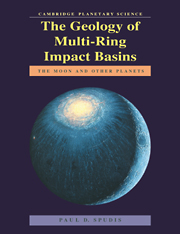Book contents
- Frontmatter
- Contents
- Preface
- 1 The multi-ring basin problem
- 2 From crater to basin
- 3 The ‘archetype’ basin: Orientale
- 4 An ancient basin: Nectaris
- 5 A modified basin: Crisium
- 6 A transitional basin: Serenitatis
- 7 The largest basin: Imbrium
- 8 Geological processes in the formation of lunar basins
- 9 Multi-ring basins on the terrestrial planets
- 10 Multi-ring basins and planetary evolution
- References
- Index
10 - Multi-ring basins and planetary evolution
Published online by Cambridge University Press: 12 October 2009
- Frontmatter
- Contents
- Preface
- 1 The multi-ring basin problem
- 2 From crater to basin
- 3 The ‘archetype’ basin: Orientale
- 4 An ancient basin: Nectaris
- 5 A modified basin: Crisium
- 6 A transitional basin: Serenitatis
- 7 The largest basin: Imbrium
- 8 Geological processes in the formation of lunar basins
- 9 Multi-ring basins on the terrestrial planets
- 10 Multi-ring basins and planetary evolution
- References
- Index
Summary
The formation of multi-ring basins is one of the most important geological processes in the early history of the Solar System. These impacts can greatly affect the morphology and observed surface composition of planetary crusts. The formation of basins may influence lithospheric development and growth and thus alter the thermal history of the planet. Basin-forming impacts can catalyze volcanic eruptions and initiate major modifications of crustal structure subsequent to the development of their multi-ring topography.
In this chapter, I will conclude my examination of the geology of multi-ring basins by speculating on the role of basins in the early geological evolution of the planets. Many of the ideas offered in this chapter are subjects of ongoing research and answers to some of the questions raised by such speculation may be forthcoming with additional work.
The building blocks of planetary surfaces
The recognition of regional patterns of landforms on the Moon led to the discovery of multi-ring basins; this pattern recognition of “the big picture” out of the chaos of detail displayed by the lunar surface is well described by Hartmann (1981). The use of such perception techniques in planetary photogeology has shown us that basins are also present on Mercury, Mars, and the icy satellites of the jovian planets. Moreover, such discovery is not yet complete; ongoing analysis of planetary images adds every year to the basin inventory of the Solar System.
From the evidence described and analyzed in this book, I believe that basins are the fundamental building blocks of early, planetary crusts.
- Type
- Chapter
- Information
- The Geology of Multi-Ring Impact BasinsThe Moon and Other Planets, pp. 224 - 231Publisher: Cambridge University PressPrint publication year: 1993

